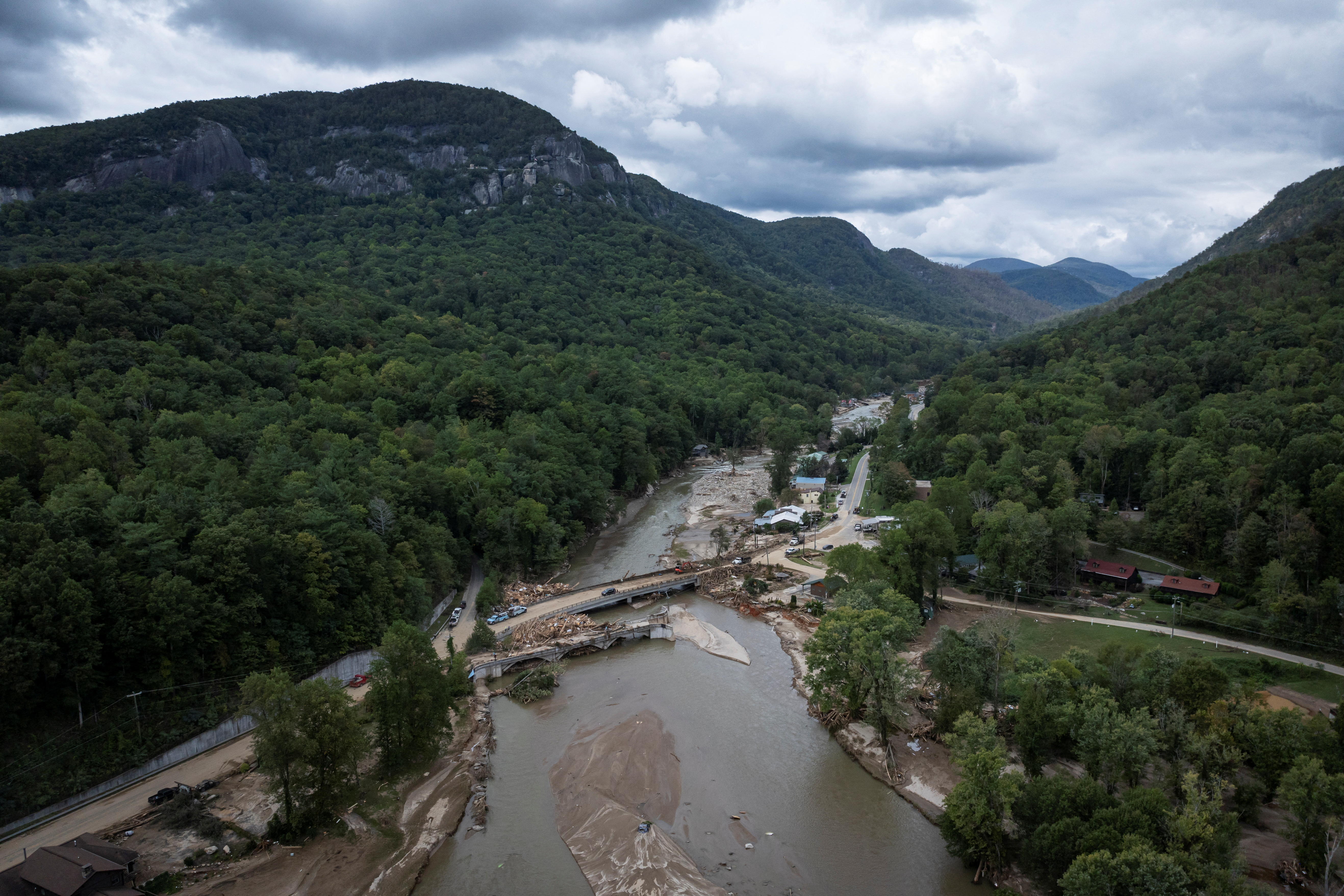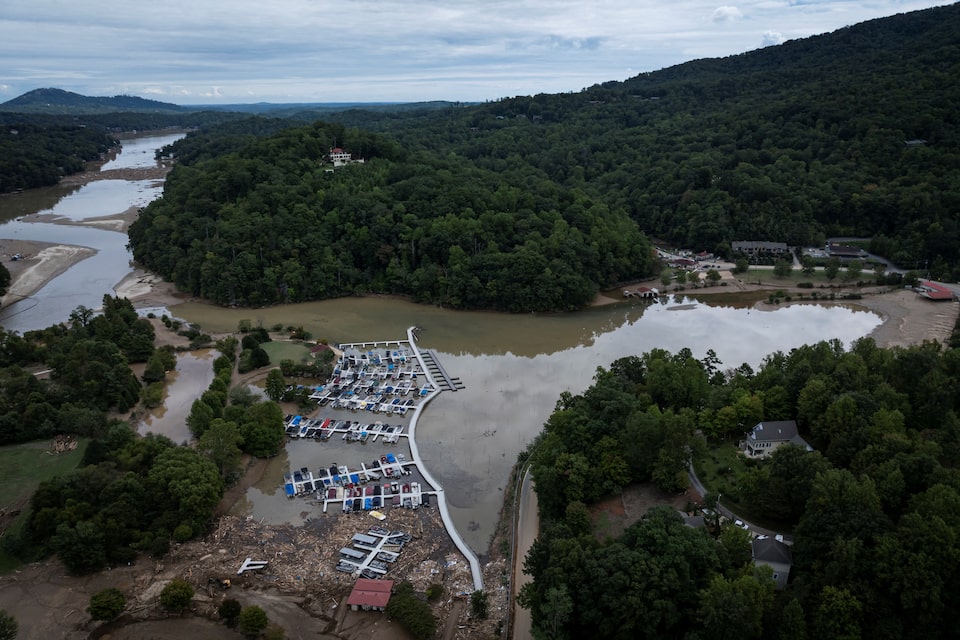A drone view shows a damaged area following the passing of Hurricane Helene, in Lake Lure, North Carolina, U.S., October 1, 2024. REUTERS

A drone view shows a damaged area following the passing of Hurricane Helene, in Lake Lure, North Carolina, U.S., October 1, 2024. REUTERS

A drone view shows a damaged area following the passing of Hurricane Helene, in Lake Lure, North Carolina, U.S., October 1, 2024. REUTERS
Summary
- Recovery will cost billions over several years, DHS says
- At least 162 dead in six states, CNN reports
- Some 1.5 million homes and businesses are without power
ASHEVILLE, North Carolina, Oct 1 (Reuters) – Search-and-rescue teams who have already saved hundreds of people scoured the mountains of western North Carolina for more survivors on Tuesday, working amid washed-out roads, smashed bridges and felled power lines following Hurricane Helene.
The storm has killed at least 162 people in North Carolina, South Carolina, Georgia, Florida, Tennessee and Virginia, CNN reported, citing state and local officials, and the death toll is expected to rise once rescue teams reach isolated towns and telecommunications are restored.
The death toll rose after North Carolina’s Buncombe County reported 57 dead on Tuesday, up from 40 a day earlier.
The mountainous area including the county seat of Asheville bore the brunt of the storm, which U.S. Homeland Security Secretary Alejandro Mayorkas said was of “historic magnitude.”
Recovery will involve a “multibillion-dollar undertaking” lasting years, Mayorkas told reporters at the White House.
President Joe Biden vowed to “jumpstart this recovery process” after speaking with governors and other leaders in the impacted areas.
“People are scared to death. People wonder whether they’re going to make it. We still haven’t heard from a whole lot of people. This is urgent,” Biden said.
Hundreds of people have been reported missing, a number that is expected to decline as more telecommunications come back on line and emergency workers are able to get into remote areas.
Sonia Ferreira has come to see what’s left her home in Atafona, Brazil, where a rising Atlantic Ocean is eating away the coastline…
The North Carolina National Guard has rescued over 500 people, deploying helicopters to ferry in supplies and rescue workers, rescuing survivors and pets along the way, Major General Todd Hunt told a separate press briefing.
Among the victims in North Carolina’s McDowell County was David Carver, 58, who had attempted to divert water away from his home in Linville Falls, according to a friend who tried to save him.
As Carver worked with a shovel in driving rain on Friday, half his house gave way in a mudslide, taking him down the hillside with it.
His life-long friend and neighbor Ken Fisher, 60, rushed to help after Carver was swept into a drainage pipe where he was trapped by trees and other debris.
Fisher poured water over Carver’s face to wash off mud so he could open his eyes, told him his wife was safe and prayed with him.
“I told him I wasn’t going to let him die there, I said ‘I’m going to get you out of there,” Fisher recalled. He stayed with Carver for 11 hours until emergency personnel were able to get him out of the pipe.
Carver died in hospital at around 4 a.m. on Saturday from trauma to internal organs.
A 5,000-YEAR EVENT
Some locations of western North Carolina may have experienced a 5,000-year event, so perfect were conditions to create maximum precipitation, said Tennessee state climatologist Andrew Joyner.
A storm prior to Helene sucked moisture from the Gulf of Mexico and saturated areas like Mount Mitchell, the highest point in the Appalachian mountains above hard-hit communities like Swannanoa and Black Mountain. Then Helene approached at the perfect angle to rise over the peak, intensifying rainfall.
“The event was a perfect storm,” Joyner said.
Taylor Jones, director of Buncombe County Emergency Services, was surveying the damage in Swannanoa after Friday’s flood that consumed several houses and large parts of a church.
“This is a true disaster,” Jones said, speaking to resident Ryan O’Keefe. “This is not going to be something that can be fixed right away. This is not a sprint. This is more like two or three marathons.”
Power outages were down to 420,000 from a peak of 1 million in North Carolina with all but two hospitals in the west of the state back on commercial power, said state Health Department Secretary Kody Kinsley. Access to public drinking water systems was scarce.
In all 1.5 million homes and businesses in six states from Florida to West Virginia remained without power on Tuesday morning, according to the website Poweroutage.us.
Reporting by Bernie Woodall in Asheville, North Carolina, Karl Plume in Shelby, North Carolina, Andrew Hay in Taos, New Mexico, and Rich McKay in Atlanta; Writing by Jonathan Allen and Daniel Trotta; Editing by Edwina Gibbs, Ed Osmond and Sandra Maler





